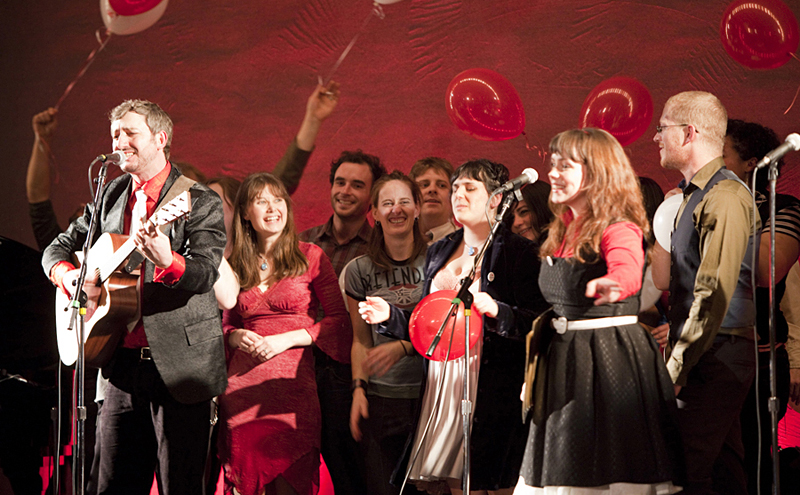For the sake of a bad pun, Sasquatch leaves a big footprint. Since 2002, the indie-rock festival held at the Gorge on Memorial Day weekend has brought such top-notch talent as Björk, the Beastie Boys, Modest Mouse, the Flaming Lips, and dozens more. But between the fuel used by artists and fans driving several hours to the Gorge, not to mention the energy used to power the amphitheater, Sasquatch has also been responsible for its fair share of pollution.
According to Elie Rothschild of the San Francisco–based group Carbon Harmony, last year’s two-day festival put 1,400 tons of carbon emissions into the earth’s atmosphere, and the 2006 fest, one day longer, about 3,000 tons. These emissions add up to what is called a “carbon footprint,” essentially the measure of an individual’s or business’ contribution to global warming.
Compared to enterprises like the Ford Motor Company, Sasquatch’s footprint is relatively minor. But it was eye-opening to founder Adam Zacks when it occurred to him that his festival was encouraging thousands of people to get in their cars and drive hundreds of miles. Last year, Sasquatch joined a growing number of companies (Pepsi-Cola, Dell, and Whole Foods among them) by going “carbon neutral.” The festival is doing it again this year, but taking it a step further: aiming to be carbon negative.
Akin to “sustainable” and “green,” the term “carbon neutral” is largely a public relations tool. Critics argue that it means exactly what it says: not doing anything to hurt the environment, but not doing anything to help it either. If a company decides to go carbon neutral, firms such as Carbon Harmony tally the size of its carbon footprint. Then those firms “offset” those emissions by investing an equal amount of the polluter’s money in renewable energy sources. Sasquatch’s offsets will go to Pacific Northwest cattle farms that convert animal waste into electricity.
But carbon neutrality does nothing to reduce emissions per se—hence the criticism from environmental groups like Friends of the Earth, which claims carbon offsets give people the gift of guilt-free pollution. “With something like Sasquatch, the best thing [carbon neutrality] does is create awareness of the issue,” says David Willett, national press secretary for the Sierra Club. “If you’ve got a lot of impressionable young people going to the festival or checking out the Web site, it’s giving them direct lines to this information.”
Sasquatch’s web site defines carbon neutrality as “a way to reduce the amount of carbon emitted in one place by eliminating it from another place. This produces a net carbon output of zero.” But as Willett points out, this is PR-speak for “the pollution level stays the same.” Even if Sasquatch 2008 reaches its carbon-negative goal by offsetting 125 percent of its carbon emissions, it will still produce more pollution than last year, simply by being one day longer. Willett does, however, offer a solid argument in carbon neutrality’s favor: It creates financial interest in clean energy where there wasn’t previously.
When asked what Sasquatch organizers could be doing to reduce on-site pollution, Willett advises that they offer incentives to attendees who carpool, pack their own food, and bring their own reusable water bottles. He also says the organizers could power the show with solar panels and biodiesel generators and purchase clean-power catering. Manchester, Tennessee’s Bonnaroo, for instance, features one solar-powered stage, and all non-music generators are run on alternative fuels.
But the real work, Willett says, should be done by the people doing most of the polluting: the attendees. A quick scroll through the Web sites of similarly huge festivals, such as Bonnaroo and Coachella in Indio, California, provides a wealth of information on how each festivalgoer can reduce his or her environmental impact. They stress using air conditioning sparingly while driving to the festival, as well as putting your car in neutral while waiting in festival traffic. Anyone carpooling (defined as four or more to a car) to Coachella is eligible to win VIP tickets to the fest for life. Coachella also has recycling stations at which for every ten empty water bottles you deposit, you get a full one free, while Bonnaroo’s Web site boasts that of the 593 tons of waste produced at the 2007 festival, 60 percent was recycled.
Meanwhile, Zacks says Sasquatch is encouraging carpools through a ride-share board (that information is available by clicking sponsor Esurance’s link on the festival Web site). And last year, Zacks enlisted the help of activist group Global Inheritance, whose TRASHed store offered merchandise, such as skateboards autographed by the Beastie Boys, in exchange for a monetary equivalent in recyclable materials. (Unfortunately, all statistics on recycling at Sasquatch were lost when Live Nation took over the Gorge last year and fired its general manager.)
“The recycling issue has been a challenge because of the remote locale and [because there is] no existing recycling program in the area,” says Zacks. “Last year, we bagged everything up and trucked it out to the nearest recycling center, burning fuel every step of the way. It’s far from perfect, but it represents major progress over the last two years.”








